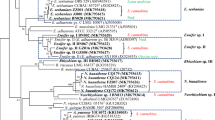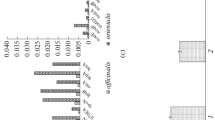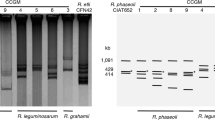Abstract
The associations among rhizobia chromosomal background, nodulation genes, legume plants, and geographical regions are very attractive but still unclear. To address this question, we analyzed the interactions among rhizobia rDNA genotypes, nodC genotypes, legume genera, as well as geographical regions in the present study. Complex relationships were observed among them, which may be the genuine nature of their associations. The statistical analyses indicate that legume plant is the key factor shaping both rhizobia genetic and symbiotic diversity. In the most cases of our results, the nodC lineages are clearly associated with rhizobial genomic species, demonstrating that nodulation genes have co-evolved with chromosomal background, though the lateral transfer of nodulation genes occurred in some cases in a minority. Our results also support the hypothesis that the endemic rhizobial populations to a certain geographical area prefer to have a wide spectrum of hosts, which might be an important event for the success of both legumes and rhizobia in an isolated region.


Similar content being viewed by others
References
Aguilar OM, Riva O, Peltzer E (2004) Analysis of Rhizobium etli and of its symbiosis with wild Phaseolus vulgaris supports coevolution in centers of host diversification. Proc Natl Acad Sci USA 101:13548–13553
Allen ON, Allen EK (1981) The Leguminosae: a source book of characteristics, uses, and nodulation. University of Wisconsin Press, Madison
Anson CE, Creaser CS, Downie JA, Egyed O, Malkov AV, Mojovic L, Stephenson GR, Turner AT, Wilson KE (1998) Organometallic flavonoid derivatives as spectroscopic probes. Bioorg Med Chem Lett 8:3549–3554
Chen W, Wang E, Wang S, Li Y, Chen X, Li Y (1995) Characteristics of Rhizobium tianshanense sp. nov., a moderately and slowly growing root nodule bacterium isolated from an arid saline environment in Xinjiang, People's Republic of China. Int J Syst Bacteriol 45:153–159
Chen WF, Guan SH, Zhao CT, Yan XR, Man CX, Wang ET, Chen WX (2008) Different Mesorhizobium species associated with Caragana carry similar symbiotic genes and have common host ranges. FEMS Microbiol Lett 283:203–209
Chen WM, Moulin L, Bontemps C, Vandamme P, Bena G, Boivin-Masson C (2003) Legume symbiotic nitrogen fixation by beta-proteobacteria is widespread in nature. J Bacteriol 185:7266–7272
Chen WX, Tan ZY, Gao JL, Li Y, Wang ET (1997) Rhizobium hainanense sp. nov., isolated from tropical legumes. Int J Syst Bacteriol 47:870–873
Chen WX, Yan GH, Li JL (1988) Numerical taxonomy study of fast-growing soybean rhizobia and proposal that Rhizobium fredii be assigned to Sinorhizobium gen. nov. Int J Syst Bacteriol 38:392–397
Collins-Emerson JM, Terzaghi EA, Scott DB (1990) Nucleotide sequence of Rhizobium loti nodC. Nucleic Acids Res 18:6690
Day MJ, Burton NF, Bull AT (1988) A comparison of plasmid distribution in sediment bacteria isolated from clean and naphthalene polluted sites. Lett Appl Microbiol 7:71–73
Denison RF (2000) Legume sanctions and the evolution of symbiotic cooperation by rhizobia. Am. Nat. 156:567–576
Donate-Correa J, Leon-Barrios M, Hernandez M, Perez-Galdona R, del Arco-Aguilar M (2007) Different Mesorhizobium species sharing the same symbiotic genes nodulate the shrub legume Anagyris latifolia. Syst Appl Microbiol 30:615–623
Doyle JJ (1994) Phylogeny of the legume family: an approach to understanding the origins of nodulation. Annu Rev Ecol Syst 25:325–349
Drouin P, Prevost D, Antoun H (1996) Classification of bacteria nodulating Lathyrus japonicus and Lathyrus pratensis in northern Quebec as strains of Rhizobium leguminosarum biovar viciae. Int J Syst Bacteriol 46:1016–1024
Estrella MJ, Munoz S, Soto MJ, Ruiz O, Sanjuan J (2009) Genetic diversity and host range of rhizobia nodulating Lotus tenuis in typical soils of the Salado River Basin (Argentina). Appl Environ Microbiol 75:1088–1098
Fierer N, Jackson RB (2006) The diversity and biogeography of soil bacterial communities. Proc Natl Acad Sci USA 103:626–631
Geremia RA, Mergaert P, Geelen D, Van Montagu M, Holsters M (1994) The NodC protein of Azorhizobium caulinodans is an N-acetylglucosaminyltransferase. Proc Natl Acad Sci USA 91:2669–2673
Han TX, Han LL, Wu LJ, Chen WF, Sui XH, Gu JG, Wang ET, Chen WX (2008) Mesorhizobium gobiense sp. nov. and Mesorhizobium tarimense sp. nov., isolated from wild legumes growing in desert soils of Xinjiang, China. Int J Syst Evol Microbiol 58:2610–2618
Han TX, Wang ET, Han LL, Chen WF, Sui XH, Chen WX (2008) Molecular diversity and phylogeny of rhizobia associated with wild legumes native to Xinjiang, China. Syst Appl Microbiol 31:287–301
Han TX, Wang ET, Wu LJ, Chen WF, Gu JG, Gu CT, Tian CF, Chen WX (2008) Rhizobium multihospitium sp. nov., isolated from multiple legume species native of Xinjiang, China. Int J Syst Evol Microbiol 58:1693–1699
Handley BA, Hedges AJ, Beringer JE (1998) Importance of host plants for detecting the population diversity of Rhizobium leguminosarum biovar viciae in soil. Soil Biol Biochem 30:241–249
Haukka K, Lindstrom K, Young JP (1998) Three phylogenetic groups of nodA and nifH genes in Sinorhizobium and Mesorhizobium isolates from leguminous trees growing in Africa and Latin America. Appl Environ Microbiol 64:419–426
Hughes VM, Datta N (1983) Conjugative plasmids in bacteria of the 'pre-antibiotic' era. Nature 302:725–726
Hurek T, Wagner B, Reinhold-Hurek B (1997) Identification of N2-fixing plant- and fungus-associated Azoarcus species by PCR-based genomic fingerprints. Appl Environ Microbiol 63:4331–4339
Hynes MF, McGregor NF (1990) Two plasmids other than the nodulation plasmid are necessary for formation of nitrogen-fixing nodules by Rhizobium leguminosarum. Mol Microbiol 4:567–574
Jha PK, Nair S, Gopinathan MC, Babu CR (1995) Suitability of rhizobia-inoculated wild legumes Argyrolobium flaccidum, Astragalus graeolens, Indigofera gangetica and Lespedeza stenocarpa in providing a vegetational cover in an unreclaimed lime stone quarry. Plant Soil 177:139–149
Jukes TH, Cantor CR (1969) Evolution of protein molecules. In: Munro HN (ed) Mammalian protein metabolism p21–132. Academic, London
Kiers ET, Rousseau RA, West SA, Denison RF (2003) Host sanctions and the legume-rhizobium mutualism. Nature 425:78–81
Kumar S, Tamura K, Nei M (2004) MEGA3: integrated software for molecular evolutionary genetics analysis and sequence alignment. Brief Bioinform 5:150–163
Lafay B, Burdon JJ (1998) Molecular diversity of rhizobia occurring on native shrubby legumes in southeastern australia. Appl Environ Microbiol 64:3989–3997
Laguerre G, Fernandez MP, Edel V, Normand P, Amarger N (1993) Genomic heterogeneity among French Rhizobium strains isolated from Phaseolus vulgaris L. Int J Syst Bacteriol 43:761–767
Laguerre G, Louvrier P, Allard MR, Amarger N (2003) Compatibility of rhizobial genotypes within natural populations of Rhizobium leguminosarum biovar viciae for nodulation of host legumes. Appl Environ Microbiol 69:2276–2283
Laguerre G, Nour SM, Macheret V, Sanjuan J, Drouin P, Amarger N (2001) Classification of rhizobia based on nodC and nifH gene analysis reveals a close phylogenetic relationship among Phaseolus vulgaris symbionts. Microbiology 147:981–993
Laguerre G, van Berkum P, Amarger N, Prevost D (1997) Genetic diversity of rhizobial symbionts isolated from legume species within the genera Astragalus, Oxytropis, and Onobrychis. Appl Environ Microbiol 63:4748–4758
Martiny JBH, Bohannan BJM, Brown J H e a (2006) Microbial biogeography: putting microorganisms on the map. Nat Rev Microbiol 4:102–111
Mnasri B, Mrabet M, Laguerre G, Aouani ME, Mhamdi R (2007) Salt-tolerant rhizobia isolated from a Tunisian oasis that are highly effective for symbiotic N2-fixation with Phaseolus vulgaris constitute a novel biovar (bv. mediterranense) of Sinorhizobium meliloti. Arch Microbiol 187:79–85
Moschetti G, Peluso A, Protopapa A, Anastasio M, Pepe O, Defez R (2005) Use of nodulation pattern, stress tolerance, nodC gene amplification, RAPD-PCR and RFLP-16S rDNA analysis to discriminate genotypes of Rhizobium leguminosarum biovar viciae. Syst Appl Microbiol 28:619–631
Moulin L, Bena G, Boivin-Masson C, Stepkowski T (2004) Phylogenetic analyses of symbiotic nodulation genes support vertical and lateral gene co-transfer within the Bradyrhizobium genus. Mol Phylogenet Evol 30:720–732
Normand P, Lapierre P, Tisa LS, Gogarten JP, Alloisio N, Bagnarol E, Bassi CA, Berry AM, Bickhart DM, Choisne N, Couloux A, Cournoyer B, Cruveiller S, Daubin V, Demange N, Francino MP, Goltsman E, Huang Y, Kopp OR, Labarre L, Lapidus A, Lavire C, Marechal J, Martinez M, Mastronunzio JE, Mullin BC, Niemann J, Pujic P, Rawnsley T, Rouy Z, Schenowitz C, Sellstedt A, Tavares F, Tomkins JP, Vallenet D, Valverde C, Wall LG, Wang Y, Medigue C, Benson DR (2007) Genome characteristics of facultatively symbiotic Frankia sp. strains reflect host range and host plant biogeography. Genome Res 17:7–15
Novikova NI, Pavlova EA, Vorobjev NI, Limeshchenko EV (1994) Numerical taxonomy of Rhizobium strains from legumes of the temperate zone. Int J Syst Bacteriol 44:734–742
O'Brien TF, Pla MP, Mayer KH, Kishi H, Gilleece E, Syvanen M, Hopkins JD (1985) Intercontinental spread of a new antibiotic resistance gene on an epidemic plasmid. Science 230:87–88
Peng GX, Tan ZY, Wang ET, Reinhold-Hurek B, Chen WF, Chen WX (2002) Identification of isolates from soybean nodules in Xinjiang Region as Sinorhizobium xinjiangense and genetic differentiation of S. xinjiangense from Sinorhizobium fredii. Int J Syst Evol Microbiol 52:457–462
Perez-Galdona R, Corzo J, Leon-Barrios MA, Gutierrez-Navarro AM (1992) Characterization of an aromatic amino acid aminotransferase from Rhizobium leguminosarum biovar trifolii. Biochimie 74:539–544
Ponsonnet C, Nesme X (1994) Identification of Agrobacterium strains by PCR-RFLP analysis of pTi and chromosomal regions. Arch Microbiol 161:300–309
Prévost D, Bordeleau LM, Caudry-Reznick S, Schulman HM, Antoun H (1987) Characteristics of rhizobia isolated from three legumes indigenous to the Canadian high arctic: Astragalus alpinus, Oxytropis maydelliana and Oxytropis arctobia. Plant Soil 98:313–324
Rivas R, Laranjo M, Mateos PF, Oliveira S, Martinez-Molina E, Velazquez E (2007) Strains of Mesorhizobium amorphae and Mesorhizobium tianshanense, carrying symbiotic genes of common chickpea endosymbiotic species, constitute a novel biovar (ciceri) capable of nodulating Cicer arietinum. Lett Appl Microbiol 44:412–418
Roche P, Maillet F, Plazanet C, Debelle F, Ferro M, Truchet G, Prome JC, Denarie J (1996) The common nodABC genes of Rhizobium meliloti are host-range determinants. Proc Natl Acad Sci USA 93:15305–15310
Saitou N, Nei M (1987) The neighbor-joining method: a new method for reconstructing phylogenetic trees. Mol Biol Evol 4:406–425
Sarita S, Sharma PK, Priefer UB, Prell J (2005) Direct amplification of rhizobial nodC sequences from soil total DNA and comparison to nodC diversity of root nodule isolates. FEMS Microbiol Ecol 54:1–11
Schofield PR, Gibson AH, Dudman WF, Watson JM (1987) Evidence for genetic exchange and recombination of Rhizobium symbiotic plasmids in a soil population. Appl Environ Microbiol 53:2942–2947
Simms EL, Taylor DL, Povich J, Shefferson RP, Sachs JL, Urbina M, Tausczik Y (2006) An empirical test of partner choice mechanisms in a wild legume–rhizobium interaction. Proc Biol Sci 273:77–81
Simon RD, Shilo M, Hastings JW (1982) The absence of a correlation between plasmids and luminescence in marine luminous bacteria. Curr Microbiol 7:175–180
Spaink HP, Wijfjes AH, van der Drift KM, Haverkamp J, Thomas-Oates JE, Lugtenberg BJ (1994) Structural identification of metabolites produced by the NodB and NodC proteins of Rhizobium leguminosarum. Mol Microbiol 13:821–831
Sprent J (2003) Plant biology: mutual sanctions. Nature 422:672–674
Sundin GW, Demezas DH, Bender CL (1994) Genetic and plasmid diversity within natural populations of Pseudomonas syringae with various exposures to copper and streptomycin bactericides. Appl Environ Microbiol 60:4421–4431
Suominen L, Roos C, Lortet G, Paulin L, Lindstrom K (2001) Identification and structure of the Rhizobium galegae common nodulation genes: evidence for horizontal gene transfer. Mol Biol Evol 18:907–916
Tan ZY, Wang ET, Peng GX, Zhu ME, Martinez-Romero E, Chen WX (1999) Characterization of bacteria isolated from wild legumes in the north-western regions of China. Int J Syst Bacteriol 49:1457–1469
Terefework Z, Kaijalainen S, Lindstrom K (2001) AFLP fingerprinting as a tool to study the genetic diversity of Rhizobium galegae isolated from Galega orientalis and Galega officinalis. J Biotechnol 91:169–180
Thompson JD, Higgins DG, Gibson TJ (1994) CLUSTAL W: improving the sensitivity of progressive multiple sequence alignment through sequence weighting, position-specific gap penalties and weight matrix choice. Nucleic Acids Res 22:4673–4680
Tian CF, Wang ET, Han TX, Sui XH, Chen WX (2007) Genetic diversity of rhizobia associated with Vicia faba in three ecological regions of China. Arch Microbiol 188:273–282
Turner SL, Young JP (2000) The glutamine synthetases of rhizobia: phylogenetics and evolutionary implications. Mol Biol Evol 17:309–319
Ulrich A, Zaspel I (2000) Phylogenetic diversity of rhizobial strains nodulating Robinia pseudoacacia L. Microbiology 146:2997–3005
Vauterin L, Vauterin P (1992) Computer-aided objective comparison of electrophoresis patterns for grouping and identification of microorganisms. Eur Microbiol 1:37–41
Vinuesa P, Leon-Barrios M, Silva C, Willems A, Jarabo-Lorenzo A, Perez-Galdona R, Werner D, Martinez-Romero E (2005) Bradyrhizobium canariense sp. nov., an acid-tolerant endosymbiont that nodulates endemic genistoid legumes (Papilionoideae: Genisteae) from the Canary Islands, along with Bradyrhizobium japonicum bv. genistearum, Bradyrhizobium genospecies alpha and Bradyrhizobium genospecies beta. Int J Syst Evol Microbiol 55:569–575
Vinuesa P, Silva C, Lorite MJ, Izaguirre-Mayoral ML, Bedmar EJ, Martinez-Romero E (2005) Molecular systematics of rhizobia based on maximum likelihood and Bayesian phylogenies inferred from rrs, atpD, recA and nifH sequences, and their use in the classification of Sesbania microsymbionts from Venezuelan wetlands. Syst Appl Microbiol 28:702–716
Wang ET, van Berkum P, Beyene D, Sui XH, Dorado O, Chen WX, Martinez-Romero E (1998) Rhizobium huautlense sp. nov., a symbiont of Sesbania herbacea that has a close phylogenetic relationship with Rhizobium galegae. Int J Syst Bacteriol 48(Pt 3):687–699
Wang H, Man CX, Wang ET, Chen WX (2009) Diversity of rhizobia and interactions among the host legumes and rhizobial genotypes in an agricultural-forestry ecosystem. Plant Soil 314:169–182
Wernegreen JJ, Harding EE, Riley MA (1997) Rhizobium gone native: unexpected plasmid stability of indigenous Rhizobium leguminosarum. Proc Natl Acad Sci USA 94:5483–5488
Wernegreen JJ, Riley MA (1999) Comparison of the evolutionary dynamics of symbiotic and housekeeping loci: a case for the genetic coherence of rhizobial lineages. Mol Biol Evol 16:98–113
West SA, Kiers ET, Simms EL, Denison RF (2002) Sanctions and mutualism stability: why do rhizobia fix nitrogen? Proc Biol Sci 269:685–694
Yan AM, Wang ET, Kan FL, Tan ZY, Sui XH, Reinhold-Hurek B, Chen WX (2000) Sinorhizobium meliloti associated with Medicago sativa and Melilotus spp. in arid saline soils in Xinjiang, China. Int J Syst Evol Microbiol 50(Pt 5):1887–1891
Yan XR, Chen WF, Fu JF, Lu YL, Xue CY, Sui XH, Li Y, Wang ET, Chen WX (2007) Mesorhizobium spp. are the main microsymbionts of Caragana spp. grown in Liaoning Province of China. FEMS Microbiol Lett 271:265–273
Zahran HH (2001) Rhizobia from wild legumes: diversity, taxonomy, ecology, nitrogen fixation and biotechnology. J Biotechnol 91:143–53
Zahran HH (1999) Rhizobium-legume symbiosis and nitrogen fixation under severe conditions and in an arid climate. Microbiol Mol Biol Rev 63:968–989
Zhang XX, Kosier B, Priefer UB (2001) Genetic diversity of indigenous Rhizobium leguminosarum bv. viciae isolates nodulating two different host plants during soil restoration with alfalfa. Mol Ecol 10:2297–2305
Acknowledgments
We thank Prof. Fu Suo Zhang for providing fund for nodule collection and Prof. Ge Hong Wei for providing seeds of some wild leguminous plants. We also very thank Dr. Li Li Han for her kind help in experiments. This work was supported by National Basic Research Program of China (2006CB100206), National Program for Basic S & T Platform Construction (2005DKA21201-10), and National Natural Science Foundation of China (30670001 and 30400001). ETW was supported by the project of SIP 20070538 and 20080322 authorized by IPN, México.
Author information
Authors and Affiliations
Corresponding author
Electronic supplementary material
Below is the link to the electronic supplementary material.
Supplementary Fig. 1
Phylogenetic tree of 16S rDNA sequences showing the relationships among the representative isolates and the reference strains for defined rhizobial species. The neighbor-joining tree was derived from a 16S rDNA sequence distance matrix (Jukes-Cantor). Bootstrap confidence levels greater than 50% are indicated at the internodes. The scale bar represents 1% of nucleotide substitutions (DOC 105 kb)
Supplementary Fig. 2
Phylogenetic tree of MLSA based on concatenated sequences of atpD, glnII, recA, and IGS. The strains analyzed in each locus and those whose sequences of all four loci being available from the GenBank database were included. Bootstrap confidence levels greater than 50% are indicated at the internodes. Bar 2% nucleotide divergence (DOC 79 kb)
Supplementary Fig. 3
Phylogenetic tree of nodC gene sequences showing the relationships among the representative strains and the related bacterial species. The neighbor-joining dendrogram was derived from a nodC sequence distance matrix (Jukes-Cantor). Bootstrap confidence levels greater than 50% are indicated at the internodes. Scale bar 5% nucleotide divergence (DOC 120 kb)
Rights and permissions
About this article
Cite this article
Han, T.X., Tian, C.F., Wang, E.T. et al. Associations Among Rhizobial Chromosomal Background, nod Genes, and Host Plants Based on the Analysis of Symbiosis of Indigenous Rhizobia and Wild Legumes Native to Xinjiang. Microb Ecol 59, 311–323 (2010). https://doi.org/10.1007/s00248-009-9577-x
Received:
Accepted:
Published:
Issue Date:
DOI: https://doi.org/10.1007/s00248-009-9577-x




